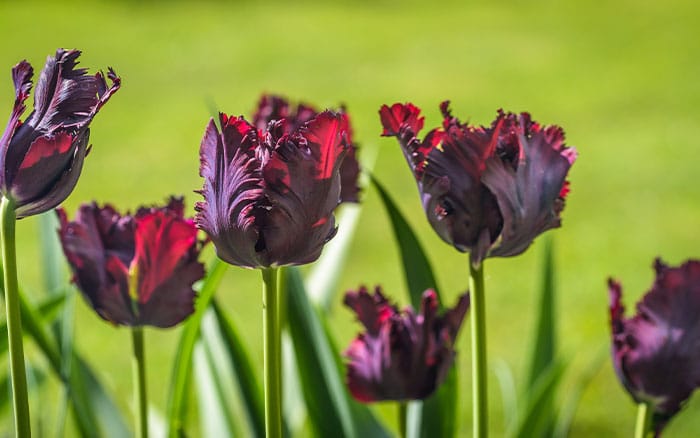Updated 22/09/25
Get ahead and plant these spring-flowering bulbs this autumn for a brilliant display of blooms next year.
Before you get planting, be sure there’s the perfect spot ready to suit the plants as some bulbs need a specific home.
Most hardy bulbs like daffodils and tulips like a warm and sunny spot with good drainage. And those plants that are from cooler habitats need to be grown in similar conditions. Before planting, improve light, sandy soils with garden compost and add compost and grit to heavier soils.
For a colourful spectacle, plant groups of 6 more bulbs. This is a great idea as when they bloom next year, it’ll be a welcome display.
Vibrant varieties
Tulip ‘Black Parrot’
Firstly, for dark and dramatic colour, this bulbous perennial can grow up to 50cm in height. The deep purple to black flowers with frilled margins will add plenty of interest to contrast with your other bright blooms.
• Sun – Full sun
• Position – South, West or East facing
• Exposure – Sheltered
• Moisture – Well-drained
• Soil – Loam, sand or chalk

Allium hollandicum (Dutch garlic) ‘Purple Sensation’
Next up, is a must-have bulb for rounded umbels of purple flowers. This perennial grows up to 90cm to provide some height to your border. Whilst you enjoy the magical texture and the scent of garlic, pollinators will love the flowers too.
• Sun – Full sun
• Position – South, West, North or East facing
• Exposure – Sheltered
• Moisture – Moist but well-drained or well-drained
• Soil – Sand, clay, chalk or loam

Ranunculus (Persian buttercup) ‘Aviv Red’
Rosy red flowerheads that are larger than average flowers will add some vibrancy to the display, complementing purple, orange, and yellow blooms. They are long lasting flowers, so will continue to provide rose-like blooms if spent flowers are deadheaded.
• Sun – Full sun
• Position – South, East or West facing
• Exposure – Sheltered
• Moisture – Moist but well-drained
• Soil – Clay, loam or sand

Fritillaria imperialis (crown imperial)
A hardy perennial with upright stems topped with an umbel of bell-shaped orange flowers beneath a crown of bracts rising upwards. They are stunning ornamental plants that without a doubt add intrigue and interest to the border. Alternatively, use them to contrast with traditional native plants in a cottage garden.
• Sun – Full sun
• Position – South, North, East or West facing
• Exposure – Exposed or sheltered
• Moisture – Well-drained
• Soil – Chalk, loam or sand

Pretty picks
Muscari azureum (azure grape hyacinth)
The flowers look small and delicate, but the plant is very hardy and low maintenance. Perfect for cottage gardens, courtyard gardens or in containers on a patio. In addition, they are very popular with pollinators, especially bees when they flower in April or May.
• Sun – Partial shade or full sun
• Position – North, East, South or West facing
• Exposure – Sheltered or exposed
• Moisture – Well-drained or moist but well-drained
• Soil – Chalk, loam, sand or clay

Erythronium revolutum (mahogany fawn lily)
The brown and green mottled leaves are joined by nodding pink, dainty flowers that bloom on thin stems. In a rock garden, or wildflower meadow they will grow well, as well as underplanting of shrubs or roses.
• Sun – Partial shade
• Position – South, East, North or West facing
• Exposure – Exposed or sheltered
• Moisture – Well-drained or moist but well-drained
• Soil – Chalk, sand, clay or loam

Hyacinth ‘Pink Pearl’
Pretty and pink, these hyacinths are perfect for the front of a border where they will grow to 30cm tall. Flowering in March or April, they’ll be around in time for the spring pollinators. They are attracted to the delicious nectar and pollen rich flowers.
• Sun – Full sun or partial shade
• Position – North, West, East or South facing
• Exposure – Sheltered
• Moisture – Well-drained or moist but well-drained
• Soil – Clay, chalk, loam or sand

Cyclamen coum (eastern cyclamen)
Bringing early spring colour to the garden, blooming between December and March. These perennials can grow to 10cm with flowers 2cm in width ranging from pink and purple colours. Brightening up the front of borders, these may be little, but they are hardy flowers.
• Sun – Partial shade
• Position – North, West, South or East facing
• Exposure – Sheltered
• Moisture – Well-drained
• Soil – Loam, sand, clay or chalk

So, get planting your bulbs this autumn to have dramatic displays in spring and summer. Without a doubt, these plants will add something special to your garden, and they’ll be worth the wait!
For more great gardening advice, make sure you head to my YouTube Channel. Make sure you’re subscribed with notifications on so you don’t miss any of my new videos.
Frequently Asked Questions
1 – When should I plant spring-flowering bulbs?
Plant most bulbs from September to November. Tulips do best in November, which reduces fungal problems. Plant before the ground becomes hard or waterlogged.
2 – How deep should I plant bulbs?
Use a depth of two to three times the bulb’s height. Plant Fritillaria imperialis 20-25 centimetres deep to anchor tall stems securely.
3 – How far apart should I space them for impact?
Space bulbs two to three bulb-widths apart. For a bold display, plant in groups of six or more, arranging clusters rather than straight lines.
4 – Can I grow these bubls in containers?
Yes. Use peat-free compost mixed with grit and ensure there are drainage holes. Plant closely without the bulbs touching. Raise pots on feet and water in.
5 – Do bulbs need watering and feeding?
Water after planting and during dry autumn spells. In spring, use a balanced slow-release fertiliser. Stop feeding after flowering to prevent soft, sappy growth.

Leave A Comment